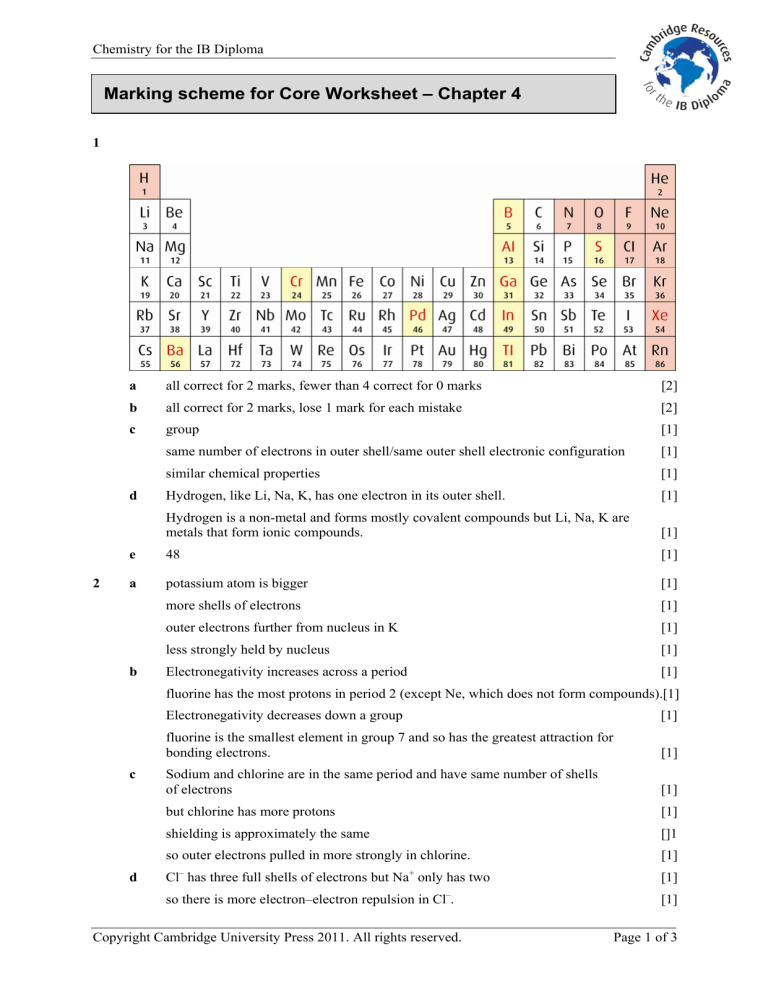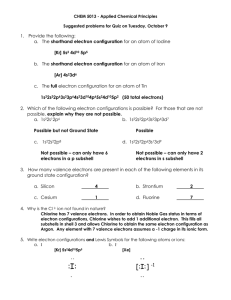Marking scheme for Core Worksheet – Chapter 4

Chemistry for the IB Diploma
Marking scheme for Core Worksheet – Chapter 4
1 a all correct for 2 marks, fewer than 4 correct for 0 marks b all correct for 2 marks, lose 1 mark for each mistake c group same number of electrons in outer shell/same outer shell electronic configuration similar chemical properties d Hydrogen, like Li, Na, K, has one electron in its outer shell.
Hydrogen is a non-metal and forms mostly covalent compounds but Li, Na, K are metals that form ionic compounds. e 48
[2]
[2]
[1]
[1]
[1]
[1]
[1]
[1]
2 a potassium atom is bigger more shells of electrons outer electrons further from nucleus in K less strongly held by nucleus b Electronegativity increases across a period [1] fluorine has the most protons in period 2 (except Ne, which does not form compounds).[1]
[1] Electronegativity decreases down a group fluorine is the smallest element in group 7 and so has the greatest attraction for bonding electrons. [1]
[1]
[1]
[1]
[1] c Sodium and chlorine are in the same period and have same number of shells of electrons but chlorine has more protons shielding is approximately the same
[1]
[1]
[]1 d so outer electrons pulled in more strongly in chlorine.
Cl
–
has three full shells of electrons but Na
+
only has two
[1]
[1] so there is more electron–electron repulsion in Cl
–
. [1]
Copyright Cambridge University Press 2011. All rights reserved. Page 1 of 3
Chemistry for the IB Diploma
3 a K
+
Ar Cl
–
[1] they all have the same number of electrons, therefore the amount of electron– electron repulsion is approximately the same [1]
K
+
has a higher nuclear charge than Ar, and Ar has a higher nuclear charge than Cl
–
[1] the electrons are pulled in more strongly by the nucleus of K
+
[1] b Al
3+
Mg
2+
Na
+
[1] they all have the same number of electrons, therefore the amount of electron–electron repulsion is approximately the same [1]
Al
3+
has a higher nuclear charge than Mg
2+
, and Mg
2+
has a higher nuclear charge than Na
+
[1] the electrons are pulled in more strongly by the nucleus of Al
3+
[1] c Cl Cl
–
I
–
[1]
Cl is smaller than Cl
–
as there is less electron–electron repulsion for the same nuclear charge [1]
I
–
has two more shells of electrons than Cl
–
[1]
4 a
2 marks for all points plotted correctly, lose 1 mark for each mistake [2] b Na–Al all have metallic bonding [1] increase in melting point as charge on the ion increases (Na
+ →
Mg
2+ →
Al
3+
) [1] the size of the ion decreases and there are more electrons in the sea of electrons from
Na to Al [1]
Si has a giant covalent structure strong covalent bonds must be broken when it is melted
[1]
[1]
P, S and Cl are covalent molecular while Ar is atomic
P
4
molecules have a lower M r
than S
8
molecules, therefore weaker van der
Waals’ forces
[1]
[1]
Cl
2
has a lower M r
than S
8
and Ar has a lower relative atomic mass than Cl
2
[1] van der Waals’ forces decrease in strength from S to Cl to Ar [1]
Copyright Cambridge University Press 2011. All rights reserved. Page 2 of 3
Chemistry for the IB Diploma
5 a 2Na + 2H
2
O
→
2NaOH + H
2
[1] b Cl
2
(aq) + 2KBr(aq)
→
Br
2
(aq) + 2KCl(aq) [1]
6 a i SO
2
[1] ii P
4
O
10
[1] b i iii Cl
2
O [1]
phosphorus(III) [1] c i ii sulfur(VI) iii chlorine(VII) ii
giant
molecular iii molecular iv giant
[1]
[1]
[1]
[1] v iv
molecular d i yes ii no iii no
yes
[1]
[1]
[1]
[1]
[1]
[1]
[1]
7 a Na
2
O(s) + H
2
O(l)
→
2NaOH(aq) [1] b MgO(s) + H
2
O(l)
→
Mg(OH)
2
(aq) [1] c P
4
O
10
(s) + 6H
2
O(l)
→
4H
3
PO
4
(aq) [1] d SO
3
(g) + H
2
O(l)
→
H
2
SO
4
(aq) [1]
8 Sodium oxide reacts with acids to form salts.
Na
2
O + 2HCl
→
2NaCl + H
2
O (or reaction with any other acid)
[1]
[1]
Copyright Cambridge University Press 2011. All rights reserved. Page 3 of 3






